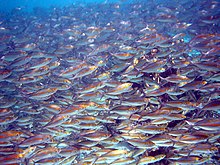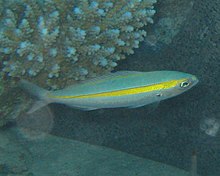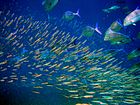Goldband fusilier
| Goldband fusilier | |
|---|---|

| |
| School of goldband fusiliers | |
| Scientific classification | |
| Kingdom: | Animalia |
| Phylum: | Chordata |
| Class: | Actinopterygii |
| Order: | Perciformes |
| Family: | Caesionidae |
| Genus: | Pterocaesio |
| Species: | P. chrysozona
|
| Binomial name | |
| Pterocaesio chrysozona (G. Cuvier, 1830)
| |
| Synonyms[2] | |
| |
The goldband fusilier (Pterocaesio chrysozona), also known as the yellowband fusilier or blacktipped fusilier, is a species of marine ray-finned fish, a fusilier belonging to the family Caesionidae. It is widespread around reefs in the Indo-West Pacific region.
Taxonomy[]
The goldband fusilier was first formally described as Caesio chryszona in 1830 by the French zoologist Georges Cuvier with the type locality given as “Archipel des Indes”, i.e. Indonesia.[3] In his 1987 review of the Caesionidae, Kent E. Carpenter placed this species within the subgenus Pisinnicaesio,[4] of which it is the type species.[5] The specific name chrysozona means “gold band”, a reference to the yellow stripe on its flanks.[6]
Description[]
The gold and fusilier has a fusiform and elongated body which is moderately laterally compressed. There are small conical teeth in the jaws and on the vomer and palatines.[4] The dorsal fin contains 10-11 spines and 14-16 soft rays while the anal fin has 3 spines and 11-13 soft rays.[2] There are scales on both the dorsal and anal fins. There are 17-20 rays in the pectoral fins.[4] This species attains a maximum total length of 21 cm (8.3 in).[2] The overall colour is pale blue to brownish fading to pinkish or white below. There is a wide yellow band along the flanks immediately below the lateral line.[7]
Distribution and habitat[]
The gold and fusilier is found in the tropical Indian and Western Pacific Oceans. It’s range extends along the eastern coast of Africa from Mozambique north to the Red Sea and eastwards across the Indian Ocean, although it is absent from the northern Arabian Sea and the Persian Gulf. In the Pacific Ocean is reaches east as far as the Solomon Islands, north to the Yaeyama Islands and south to Australia.[1] In Australia they are found around the coast from the Dampier Archipelago in Western Australia to Sydney.[7] They are at depths between 5 and 35 m (16 and 115 ft) among coral reefs, seagrass, along outer reef slopes and around pinnacles in deep lagoons.[8]
Biology[]
Goldband fusiliers are a non-migratory fish, found during the day moving in schools. At night they shelter within the reef.[8] The schools forage for zooplankton in midwater. It is an oviparous species which lays large numbers of small, pelagic eggs.[2]


Fisheries[]
Goldband fusilier play a minor role in commercial fisheries. In the Philippines, they are sometimes caught and marketed fresh using traps and drive-in nets. In the Laccadives, the Maldives and the West Pacific, they are used as baitfish for the pole and line tuna fisheries.[4]
Notes[]
- ^ a b Russell, B.; Myers, R.; Smith-Vaniz, W.F.; Carpenter, K.E.; Lawrence, A. (2016). "Pterocaesio chrysozona". IUCN Red List of Threatened Species. 2016: e.T20251507A65927387. doi:10.2305/IUCN.UK.2016-3.RLTS.T20251507A65927387.en. Retrieved 20 November 2021.
- ^ a b c d Froese, Rainer and Pauly, Daniel, eds. (2021). "Pterocaesio chrysozona" in FishBase. June 2021 version.
- ^ Eschmeyer, William N.; Fricke, Ron & van der Laan, Richard (eds.). "Species in the genus Pterocaesio". Catalog of Fishes. California Academy of Sciences. Retrieved 7 July 2021.
- ^ a b c d Kent E. Carpenter (1988). FAO Species Catalogue Volume 8 Fusilier Fishes of the World (PDF). FAO Rome. pp. 52–53.
- ^ Eschmeyer, William N.; Fricke, Ron & van der Laan, Richard (eds.). "Genera in the family Lutjanidae". Catalog of Fishes. California Academy of Sciences. Retrieved 7 July 2021.
- ^ Christopher Scharpf & Kenneth J. Lazara, eds. (5 January 2021). "Order LUTJANIFORMES: Families HAEMULIDAE and LUTJANIDAE". The ETYFish Project Fish Name Etymology Database. Christopher Scharpf and Kenneth J. Lazara. Retrieved 7 July 2021.
- ^ a b Dianne J. Bray. "Pterocaesio chrysozona". Fishes of Australia. Museums Victoria. Retrieved 7 July 2021.
- ^ a b Nguyen, N.T. and V.Q. Nguyen (2006). Biodiversity and living resources of the coral reef fishes in Vietnam marine waters. Science and Technology Publishing House, Hanoi.
References[]
- Carpenter K.E. (1988) FAO Species Catalogue: Vol 8: Fusilier fishes of the world Unipub. ISBN 978-92-5-102746-2.
- IUCN Red List least concern species
- Pterocaesio
- Fish described in 1830
- Taxa named by Georges Cuvier

